The Year of the Fish
By Michael McGuerty
The Chess Tactics Detection Workbook, by Volker Schlepütz and John Emms, Everyman Chess 2015, Paperback, 256pp. $27.95 (ChessCafe Price $23.87)
The chess world has changed. It used to be that we were entreated to study well-annotated master games as a means to improvement. Now we are being asked to examine non-annotated non-master games. In fact, we are expected to supply the annotations ourselves as well. Let me explain: in The Chess Tactics Detection Workbook, Dr Volker Schlepütz and Grandmaster John Emms present selected games from beginnersto club level players where the reader is asked tolookfor mistakes ormissed opportunities by both sides. They call itassumingthe role of a tactics detective.
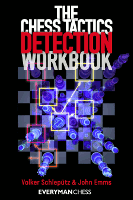
So instead of offering the typical side-to-move-and-win puzzle, the approach here is to present the bare score of a game fragment, up to the point where continuing is no longer useful for training purposes, and challenge the reader to find any missed tactical motif by either side.
The main content is divided as follows:
- Introduction
- Instructions for the Exercises
- Games of players rated 1100-1300 Elo
- Solutions: Games 1-40
- Games of players rated 1301-1500 Elo
- Solutions: Games 41-80
- Games of players rated 1501-1700 Elo
- Solutions: Games 81-120
- Glossary of Tactical Themes
For the games in each section the reader is asked to do the following exercises:
Exercise 1:
Set up a chess board. You have the White pieces. Run through the game, move by move. After each move by White, decide whether White’s move misses an opportunity for a tactic in his favour, or overlooks a tactic against himself.
There are two outcomes:
a) There was no possible tactic, either in White’s favour or against White. In this case, go on to the next pair of moves and repeat your evaluation.
b) White’s move misses a tactic in his favour, or allows a favourable tactic for Black, or both. In this case write down the relevant variations and assess the final outcome (for example, a material gain of at least a pawn). If White’s move failed to meet a tactical threat by Black, suggest alternative moves for White which would prevent the tactic. Then go on to the next pair of moves.
Exercise 2:
Restart the game and run through it a second time, now from Black’s viewpoint. Do the same as in Exercise 1. After each move by Black, decide whether Black’s move misses a tactic in his favour or overlooks tactic against himself. This exercise gives you a second chance to spot any tactics you may have overlooked in Exercise 1.
Once you have completed this, you can compare your answer to the those provided in the solutions sections. The solutions explain how and why the tactics would have worked and award points for correct answers.
Grandmaster John Emms probably needs no introduction as he is a well-known author, experienced chess coach, and Everyman editor. Dr Volker Schlepütz is said to be an ambitious amateur player and a member of the Sportfreunde Katernberg chess club in Essen, Germany, who owns a school chess license and has experience in chess coaching. He has a PhD in economics and works as a teacher at the Hochschule Fresenius University of Applied Sciences in Cologne, where he lectures in Economics and Mathematical Economics.
Emms describes their collaboration as follows: “The vast majority of the games in this book were initially selected, analysed and annotated by Volker. I added further analysis and annotations to some of these games, selected and analysed some new games, and added the glossary of tactical themes.”
Their idea is to emulate a real game situation as much as possible in that the student will not know at what point a tactic will arise and will have to work it out for themselves. The only clue that is provided is that each game contains at least one tactical possibility. In this way the same thought process can be applied in your own games. They warn that long stretches of the game may have no tactical possibilities whatsoever, and advise a time limit of 90 minutes per game.
Here is an example:
Game 1
D.Svensson-M.Marttila
Hallstahammar 2001
Colle Opening
1 d4 e6 2 Nf3 d5 3 e3 Nf6 4 Bd3 b6 5 0-0 Ba6 6 c3 g6 7 Re1 Bg7 8 Bc2 0-0 9 Ng5 h6 10 Nf3 c5 11 Nbd2 c4 12 a4 Nc6 13 e4 Qb8 14 exd5 exd5 15 b3 cxb3 16 Bxb3 Re8 (*)
In the solutions the complete game score is given, in this case a 36-move draw, and then the following missed tactics are presented:
For White
(1)
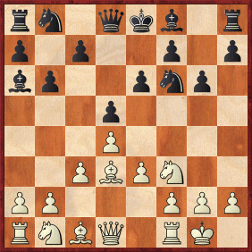
[FEN “rn1qkb1r/p1p2p1p/bp2pnp1/3p4/3P4/2PBPN2/PP3PPP/RNBQ1RK1 w kq – 0 7”]
Position after 6…g6
7 Re1?
White missed the chance to carry out a threat set up by his previous move, 6 c3. Here White can play 7 B xa6! Nxa6 8 Qa4+! (2 points) winning a piece because of the double attack on the knight and king.
(2) 8 Bc2? missed a second chance to win a piece with the same tactic: 8 Bxa6! Nxa6 9 Qa4+! followed by Qxa6. (2 points)
For Black
(3) 6…g6? overlooked the threat created by 6 c3 of Bxa6 followed by Qa4+ (1 point). The simplest way to deal with this threat is by swapping bishops: 6…Bxd3 7 Qxd3. (1 point)
You have scored ___ out of 6 points.
Tactical Themes
Double Attack
The assertion is that by focusing on games played between players rated 1100-1700 (rather than titled players), the exercises are better suited to the needs of these players, and that “games between low-rated players offer plenty of missed tactical opportunities and overlooked threats, so the material is rich in tactical themes.”
The authors even address the misgivings of potential detractors, with Volker writing
“One could argue that this kind of training could easily be done without a workbook. A player could select some random games from a database, go through the games as suggested above, and then check his or her answers with an analysis engine. Indeed, if all chess players could commit themselves to such a discipline, this workbook (and many other books which collect material for training purposes) would be useless. However, people like to have a structured environment, well-written solutions and a scoring system. In this respect, I believe we are all chess kids to some degree. Providing such players with a unique method of training is what gave me the motivation to write this book.”
It is the year of the sheep according to the Chinese zodiac, but for chess players it may well be the year of the fish. First we had a publisher produce two volumes of tactics puzzles from the games of regular players and now we have a workbook of their complete games, which we are being asked to analyze. The concept of the book is unique and its methodology valid, especially if taken to heart by the reader, who is sure to benefit from The Chess Tactics Detection Workbook. For instance, these would be good exercises for an adult to go through with a scholastic player. For me, if I want to study the games of weak players looking for missed tactics, I can study my own.
My assessment of this product:
![]()
Order The Chess Tactics Detection Workbook
by Volker Schlepütz and John Emms
A PDF file of this week’s review, along with all previous reviews, is available in the ChessCafe.com Archives.
© 2015 ChessEdu.org. All Rights Reserved.
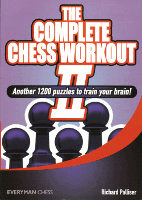
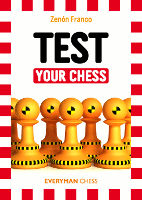
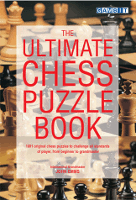
Leave a Reply